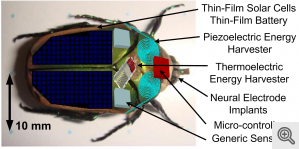I first mentioned insect cyborgs in a July 27, 2009 posting,
One last thing, I’ve concentrated on people but animals are also being augmented. There was an opinion piece [no longer available on the Courier website] by Geoff Olson (July 24, 2009) in the Vancouver Courier, a community paper, about robotic insects. According to Olson’s research (and I don’t doubt it), scientists are fusing insects with machines so they can be used to sniff out drugs, find survivors after disasters, and perform surveillance. [emphasis mine]
Today, Nov. 23, 2011, a little over two years later, I caught this news item on Nanowerk, Insect cyborgs may become first responders, search and monitor hazardous environs,
“Through energy scavenging, we could potentially power cameras, microphones and other sensors and communications equipment that an insect could carry aboard a tiny backpack,” Najafi [Professor Khalil Najafi] said. “We could then send these ‘bugged’ bugs into dangerous or enclosed environments where we would not want humans to go.”
The original Nov. 22, 2011 news release by Matt Nixon for the University of Michigan describes some of the technology,
The principal idea is to harvest the insect’s biological energy from either its body heat or movements. The device converts the kinetic energy from wing movements of the insect into electricity, thus prolonging the battery life. The battery can be used to power small sensors implanted on the insect (such as a small camera, a microphone or a gas sensor) in order to gather vital information from hazardous environments.
A spiral piezoelectric generator was designed to maximize the power output by employing a compliant structure in a limited area. The technology developed to fabricate this prototype includes a process to machine high-aspect ratio devices from bulk piezoelectric substrates with minimum damage to the material using a femtosecond laser.
Here’s a model of a cyborg insect,

Through a device invented at the University of Michigan, an insect's wing movements can generate enough electricity to power small sensors such as a tiny camera, microphone or gas sensor. (Credit: Erkan Aktakka)
This project is another example of work being funded by the US Defense Advanced Research Projects Agency (DARPA). (I most recently mentioned the agency in this Nov. 22, 2011 posting which features innovation, DARPA, excerpts from an interview with Regina Dugan, DARPA’s Director, and nanotherapeutics.)
There are many cyborgs around us already. Anybody who’s received a pacemaker, deep brain stimulator, hip replacement, etc. can be considered a cyborg. Just after finding the news item about the insect cyborg, I came across a Nov. 23, 2011 posting by Torie Bosch about cyborgs for Slate Magazine,
Though the word cyborg conjures up images of exoskeletons and computers welded to bodies, the reality is far more mundane: Anyone who has a cochlear implant, for one, could be termed a cyborg. So is the resourceful fellow who made his prosthetic finger into a USB drive. In the coming decades, we’ll see more of these subtle marriages of technology and body, creating new ethical questions.
At the blog Cyborgology, P.J. Rey, a graduate student who writes about emerging technologies, examines the trust relationships we have with the technologies—and the people who develop them—that become engrained with our daily lives. [emphasis mine]
From P. J. Rey’s Nov. 23, 2011 posting about trust and technology on Cyborgology,
In this essay, I want to continue the discussion about our relationship with the technology we use. Adapting and extending Anthony Giddens’ Consequences of Modernity, I will argue that an essential part of the cyborganic transformation we experience when we equip Modern, sophisticated technology is deeply tied to trust in expert systems. It is no longer feasible to fully comprehend the inner workings of the innumerable devices that we depend on; rather, we are forced to trust that the institutions that deliver these devices to us have designed, tested, and maintained the devices properly. This bargain—trading certainty for convenience—however, means that the Modern cyborg finds herself ever more deeply integrated into the social circuit. In fact, the cyborg’s connection to technology makes her increasingly socially dependent because the technological facets of her being require expert knowledge from others.
It’s a fascinating essay and I encourage you to read it as Rey goes on to explore social dependency, trust, and technology. On a related note, trust and/or dependency issues are likely the source of various technology panics and opposition campaigns, e.g. nuclear, GMOs (genetically modified organisms), telephone, telegraph, electricity, writing, etc.
It’s hard to understand now that literacy is so common but in a society where it is less common, the written word is not necessarily to be trusted. After all, if only one person in the room can read (or claims they can), how do you know they’re telling the truth about what’s written?
As for cyborgs, I think we’re going to have some very interesting discussions about them and these discussions may not all occur in the sanctified halls of academe or in quiet conference rooms stuffed with bureaucrats. As I’ve noted before there is a whole discussion taking place about emerging technologies in the realm of popular culture where our greatest hopes and fears are reflected and, sometimes, intensified.